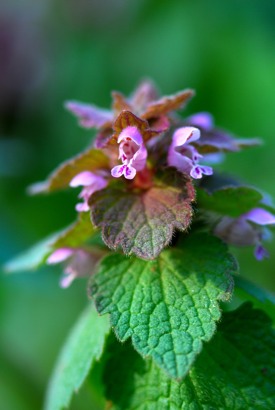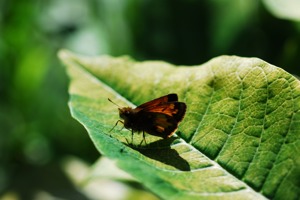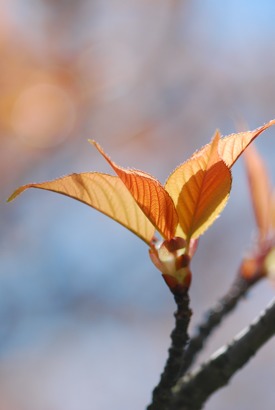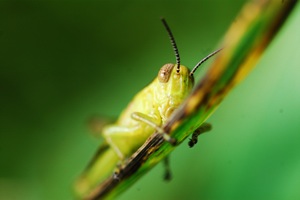Micro-Nikkor 105mm f/4 AIS Review
Overall: 5 out of 5
Optics: 5
Price on Used Market: ~$150–300 USD
Value at $225 USD: 5
Accessories: Great with PN-11 Extension Tube and TC-200/201 Teleconverters
Introduction
The classic mechanical precision of this AI lens (1977–1981), or the similar AIS (1981–1983), feels great compared to the modern version. The all-metal construction and built-in hood are wonderful things being left behind in today’s AF-S/VR world.
Micro-Nikkor 105mm f/4 AI
Taken with Nikkor-Q·C 135mm f/2.8 Pre-AI @f/5.6
Assorted Information
| Max Aperture | f/4 |
| Min Aperture | f/32 |
| Aperture Blades | 7 |
| Close Focus | .45m/18in |
| Filter Thread | 52mm |
| Hard Infinity Stop? | Yes |
| Built in Hood? | Yes |
I’ve shot with Nikon’s current Micro-Nikkor 105mm f/2.8 AF-S VR, and Canon’s current 100mm f/2.8 USM macro lenses, but not the Nikon AF version, the f/2.8 AIS, or any other Canon 100mm. This is the only one I own due to both cost and satisfaction.
Usage
This lens is supremely sharp, with excellent boke, but has the disadvantage compared to the modern version of only getting you to 1:2 reproduction rather than 1:1. I use either the PN-11 extension tube, or a TC-200 2x Teleconverter to get this to 1:1. Using a teleconverter rather than the extension tube gives this lens a really convenient working distance for 1:1 reproduction, which is useful for anything that might be scared away. Sharpness remains excellent with my TC-200.
Taken with PN-11 Extension Tube @1:1 Reproduction
Versus
To me, for Macro photography the f/2.8 VR’s only advantages are brighter viewfinder for focusing, and getting to 1:1 without an extension tube. VR is basically useless for macro. On the other hand, the 105mm f/4 macro has the advantage of a superior focusing ring which to me is a big plus as I focus manually for macro shots no matter what.
Versus Canon 100mm USM Macro
Here are 100% crops of a flower from each lens. The Nikon was taken on a D60, where as the Canon was a 5DMk2. This isn’t the best comparison, since the D60 has more densely packed photosites, and therefore 100% crops will contain more detail. For comparison, look at the originals below. Still, to me it looks to me like the Canon’s lens isn’t delivering as good sharpness per-pixel as the Nikon is at higher density which was quite surprising to me. Click to see 100%.
Nikon 100% crop @f/8 1:1 with PN-11
Canon 100% crop @f/8 1:1
Here are the full images.
Nikon full image @f/8 1:1 with PN-11
Canon full image @f/8 1:1
Here’s a couple more side-by-side comparisons. These were shot 1:1 on the Canon, and slightly less than 1:1 on the Nikon in order for the size of objects when viewed at 100% to look close to identical. Again, the Nikon comes out sharper, but honestly the difference isn’t enough to see unless making huge prints, or cropping massive amounts.
Side by Side @f/4
Another advantage of the Nikkor is that it reaches 1:1 at 17.5cm (6.95 inches) as opposed to the Canon’s 14.5cm (5.75 inches). Note I measure these distances from the end of the lens rather than the film plane as is standard. The reason for this is distance from the end of the lens is important for shooting animals, especially insects, who can easily get scared away by the lens. Since the 105mm f/4 is not an internal focus design and extends greatly in length as you focus close, it keeps your body farther from the subject, as well.
Final Word
As you can easily find it for under $200, 1/5 the cost of the AF-S version, it’s an easy buy for macro photography. I haven’t used the AF-S version enough to pass judgement on resultant image quality between the two, but I suspect I prefer this lens, and I certainly prefer it as compared to the Canon 100mm USM macro. For more general photography at this focal length, the lens speed, VR, and autofocus of the new version makes it a great purchase, though I’d probably spend a little extra and go for the 105mm DC for purposes other than macro.
More Images with this lens
Images with this lens and PN-11 Ext. Tube
D700 @f/4
Nikon PN-11 Extension Tube
Edit 2012-04-17:
Photos on D7000
These images are from some photos I took to make iPad backgrounds with, you can find that blog entry here.






























using with TC-200
I was very interested to see how using a TC 200 allows you to get to 1:1 as I happen to have one of these and the PN-11 is difficult to find or expensive. I have a 105 f2.8 MF and find this combination works really well. Not sure if there is any noticable loss of image quality using the teleconverter c.f extension rings
Posted by John Violet (anon) on 2011-04-20 08:07:04.